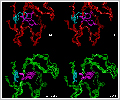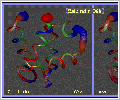| |
Structure Calculation & Analysis - Applications &
Techniques in NMR Research
Scientists at Accelrys have used FELIX for the following
structure calculations of NMR data.
Improved Accuracy and Precision of NMR Refined
Structures Using Direct Methods
Comparison of Molecular Flexibility and Conformational
Variability
-----------------------------------------------------------------------------------------------------------------------------------------
Improved Accuracy and Precision of NMR Refined
Structures Using Direct Methods
 99kb
99kb |
Using NOE crosspeak
volume buildups during refinement
significantly improves the accuracy and
precision of the structures generated[12].
Recent validation studies[13] have
demonstrated that by refining NOE volumes
directly[14], rather than derived distance
restraints, the precision and the accuracy
of a family of Zinc Rubredoxin structures
generated from simulated data of the
minimized X-ray target structure were
significantly improved. |
The average pairwise RMS to the
average backbone coordinates of 30 structures generated
using distance restraints only in a DG/rMD protocol was
0.59Å, and this RMS was reduced to 0.33Å when NOE volume
restraints were directly refined using an identical
annealing protocol. These direct methods were also
applied using the experimental data of Blake et al.[3]
Figure 9 (99kb) emphasizes the improved convergence of
the tyr-12 side-chain when NOE volume restraints,
including internal motions[11,12], were used directly
for refinement[15].
The computational efficiency of Accelrys' direct method
for the refinement of NOE crosspeak volumes is directly
linked to the efficiency of back-calculating NOE
intensities and their gradients at nearly every timestep
of a dynamics calculation. A novel algorithm termed
Matrix Doubling has been developed, which dramatically
improves the efficiency of the back-calculation of NOE
intensities[12] without compromising accuracy. For
systems containing 500 proton spins at correlation times
of 3 ns and four mixing times between 50 and 200 ms, the
efficiency of the calculation is approximately 100 times
faster than traditional matrix diagonalization
approaches. These computational improvements permit
refinements that used to take days to weeks to calculate
on state-of-the-art supercomputers or servers, to
complete in hours to days on modern desktop
workstations.
-----------------------------------------------------------------------------------------------------------------------------------------
Comparison of Molecular Flexibility and Conformational
Variability
 200kb
200kb |
A common dilemma in NMR-based
structure determination is by simply
inspecting an ensemble of structures, it is
very difficult to determine if the regions
of uncertainty within the model are due to
an incomplete set of restraints (due to
spectral overlap or experimental artifacts)
or inherent flexibility within the solution
structure. |
With the recent introduction of
relaxation measurements to measure inherent
flexibility[16], the spectroscopist can now readily
differentiate between under-constrained regions as
arising from high-mobility (since some of the NOEs tend
to be conformationally averaged to zero) or too few
restraints within a rigid region of the molecule. As an
example, the conformational variability for the ensemble
NMR model[17] generated for apo Calbindin D9k is
depicted in the right-hand panel of
Figure 11(200kb) as
a variable width ribbon, where the diameter of the
ribbon is proportional to the average heavy-atom
per-residue RMS to the average coordinates after the
backbone atoms have been superimposed. The ribbon is
color-coded according to the hydrophobicity, or charge,
of the given residue at that position along the
backbone. The left-hand panel in
Figure 11 (200kb)
depicts a similar variable width ribbon, except that the
width is varied according to the value of the
generalized order parameter (inherent backbone mobility)
calculated for the N-H vector from R1, R2 and NOE
measurements derived from 15N-directed relaxation
experiments[17].
In this example, the conformational variability of the
NMR model is correlated with the regions of high
mobility determined experimentally (the diameter of the
ribbon is approximately the same in both images). The
scientist can conclude that the unconstrained loop at
the upper right is inherently mobile and no further work
needs to be conducted to try and extract additional
constraints in this region. The differences observed in
the two calcium-binding loops pointing downwards are not
significant, since the relaxation measurements were
conducted on the calcium-loaded form, while the
structure calculations were conducted on the apo form
(no hydrogen bonds or electrostatic interactions
included).
-----------------------------------------------------------------------------------------------------------------------------------------
Back to top
More Case Studies |
|
•
Product Overview
•
Felix 2D/ND
•
Modules
 Felix 2D/ND
Felix 2D/ND
 Felix Assign
Felix Assign
 Felix
Autoscreen
Felix
Autoscreen
 Felix Model
Felix Model
•
Case Studies
 Spectral
Assignment
Spectral
Assignment
 Spectral
Processing & Analysis
Spectral
Processing & Analysis
 Structure
Calculation & Analysis
Structure
Calculation & Analysis
•
System Requirements
•
How to Try/Buy Felix |









